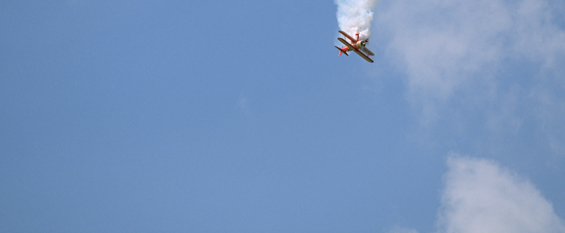SPINS FOR THE GENERAL AVIATION PILOT

In aviation, a spin is an aggravated stall resulting in rotation about the center of gravity, wherein the aircraft follows a downward corkscrew path. Spins can be entered unintentionally or intentionally, from any flight attitude and from practically any airspeed. All that is required is sufficient yaw rate while an aircraft is stalled. An incipient spin is typically driven by inputs made and held by the pilot, whereas a fully developed spin is a self-sustaining maneuver. In either case, a specific and often counterintuitive set of actions may be needed to effect recovery. If the aircraft exceeds published limitations regarding spins, is loaded improperly, or if the pilot uses incorrect technique to recover, the spin can lead to a fatal crash.
Now that the fun stuff is out of the way, let’s talk about a few types of spins. In a spin, one wing is sufficiently stalled and generates significant drag but little or no lift, while the other is not as fully stalled yet can also generate significant lift. This causes the aircraft to auto-rotate due to the non-symmetrical lift and drag. Spins are characterized by high angle of attack, low airspeed, and high rate of descent. Spins differ from spiral dives, which are characterized by low angle of attack and high airspeed. A spiral dive is not a type of stall since the wing is not stalled, and the airplane will respond to the pilot’s inputs to the flight controls.
For safety, all certificated, single-engine fixed-wing aircraft, including certificated gliders, must meet published criteria regarding stall and spin behavior. These designs typically have a wing with greater angle of attack at the wing root than at the wing tip, so that the wing root stalls first while the ailerons may remain somewhat effective until the stall migrates outward toward the wing tip. One method of tailoring such stall behavior is known as washout. Some designers of recreational aircraft seek to develop a plane that is characteristically incapable of spinning, even in an uncoordinated stall.
Flight control systems of some gliders and recreational aircraft are designed so that when the pilot moves the elevator control close to its fully aft position, such as in slow speed flights and flights at a high angle of attack, the trailing edges of both ailerons are automatically raised slightly. This is so that the angle of attack is reduced at the outboard regions of both wings. This necessitates an increase in the angle of attack at the inboard (center) regions of the wing, and promotes stalling of the inboard regions well before the wing tips.
Here is one common scenario that we all worry about as relatively new pilots who can fall into an unintentional spin: an uncoordinated turn towards the runway during the landing sequence. A pilot who is overshooting the turn to final approach may be tempted to apply rudder to increase the rate of turn. The result is twofold: the nose of the airplane drops below the horizon and the bank angle increases. Reacting to these unintended changes, the pilot may then begin to pull the elevator control aft (thus increasing the angle of attack), while applying opposite aileron to decrease bank angle. Taken to its extreme, this can result in an uncoordinated turn with sufficient angle of attack to cause the aircraft to stall. This is called a cross-control stall, and is very dangerous if it happens at low altitude where the pilot has little time to recover. In order to avoid this scenario, pilots are taught the importance of always making coordinated turns (see my article in the August/September DW).
Phases
In aircraft that are capable of recovering from a spin, there are four spin phases. In aircraft that cannot recover from a spin, there are only three phases—the developed phase is continuous, and can only be terminated by using special spin-recovery devices such as a spin-recovery parachute or contact with the ground. The latter really hurts. The four spin phases are as follows:
· Entry – The pilot provides the necessary elements for the spin, either accidentally or intentionally.
· Incipient – At least one wing of the aircraft stalls and rotation starts.
· Developed – The aircraft’s rotation rate, airspeed, and vertical speed are stabilized. At least one wing of the aircraft is stalled.
· Recovery – The angle of attack of both wings decreases below the critical angle of attack and autorotation slows. The nose attitude of the aircraft steepens, airspeed increases and autorotation stops. The idea of recovering from a spin is to make the aircraft fly again.
History
In aviation’s early days, spins were poorly understood and often fatal, as opposed to today, where spins are only sometimes poorly understood and fatal. Proper recovery procedures were unknown, and a pilot’s instinct to pull back on the stick served only to make a spin worse. Because of this, the spin earned a reputation as an unpredictable danger that might snatch an aviator’s life at any time, and against which there was no defense.
The spin was initially explored by individual pilots performing ad-hoc experiments (often accidentally) and by aerodynamicists. In August 1912, Lieutenant Wilfred Parke RN became the first aviator to recover from an accidental spin when his Avro biplane entered a spin at 700 feet AGL in the traffic pattern at Larkhill. Parke attempted to recover from the spin by increasing engine speed, pulling back on the stick, and turning into the spin, with no effect. The aircraft descended 450 feet, and horrified observers braced themselves for a fatal crash.
Parke was disabled by centrifugal forces while considering a means of escape. In an effort to neutralize the forces pinning him against the right side of the cockpit, he applied full right rudder, and the aircraft leveled out fifty feet above the ground. With the aircraft now under control, Parke climbed, made another approach, and landed safely. I’m thinking the bi-line of this article’s title probably hit home for him the moment he landed safely on the ground!
Additionally, the first documented case of an actual intentional spin and recovery is that of Harry Hawker. In the summer of 1914, Hawker recovered from an intentional spin over Brooklands, England by centralizing the controls.
Entry and recovery
However, there are some aircraft that cannot be recovered from a spin using only their own flight control surfaces, and must not be allowed to enter a spin under any circumstances. Nonentheless, most typical general aviation aircraft are engineered to be very stable and not easily put into a spin. If an aircraft has not been certified for spin recovery, it should be assumed that spins are not recoverable and are unsafe in that aircraft, or consult your POH for specific information.
Spin-entry procedures vary with the type and model of aircraft being flown, but there are general procedures applicable to most all aircraft. This is for practice only and include reducing power to idle while simultaneously raising the nose in order to induce an upright stall. As the aircraft approaches stall, apply full rudder in the desired spin direction while holding full back-elevator pressure for an upright spin. Sometimes a roll input is applied in the direction opposite of the rudder (i.e., a cross-control).
If the aircraft manufacturer provides a specific procedure for spin recovery, that procedure must be used. Otherwise, to recover from an upright spin, the following generic procedure may be used: power is first reduced to idle and the ailerons are neutralized. Subsequently, full opposite rudder (that is, against the yaw) is added and held to counteract the spin rotation. The elevator control is briskly moved forward to reduce the angle of attack below the critical angle. Once the rotation has stopped, the rudder must be neutralized and the airplane returned to level flight.
In some aircraft the Mueller/Beggs technique of spin-recovery technique may effect recovery as well: power off, let go, rudder full opposite to the spin (or more simply, “push the rudder pedal that is hardest to push”), and hold. An advantage of the Mueller/Beggs technique is that there is not much to do during a very stressful and disorientating time.
Center of gravity
The characteristics of an airplane with respect to spinning are significantly influenced by the position of the center of gravity. In general terms, the further forward the center of gravity the less readily the airplane will spin, and the more readily it will recover from a spin. Conversely, the further the aft from the center of gravity, the more readily the airplane will spin and the less readily it will recover from a spin. In any airplane, the forward and aft limits on center of gravity are carefully defined. In some airplanes that are approved for intentional spinning, the aft limit at which spins may be attempted is not as far aft as the aft limit for general flying. Intentional spinning should not be attempted casually, and the most important pre-flight precaution is to determine that the airplane’s center of gravity will be within the range approved for intentional spinning.
Unrecoverable spins
Some World War II airplanes such as the Bell P-30 Airacobra, were notoriously prone to flat spins when loaded erroneously. Likewise, North American P-51 Mustangs with auxiliary fuel tanks not originally designed for the P-51 suffered from the same problem. Similarly, the Vought F4U Corsair was reputed to have appalling stall and spin recovery characteristics, even in the “clean” (no stores) configuration. Although highly resistant to entering into a spin, the Grumman F-14 Tomcat can exhibit a fast, flat spin from which it is nearly impossible to recover. A famous example of a non recoverable flat spin occurred in 1963, with Chuck Yeager at the controls of the NF-104A rocket-jet hybrid: after setting an altitude record, Yeager lost control and entered a flat spin, ejected, and survived. Needless to say, the plane was not so lucky.
Spinning for Fun
A spin is often intimidating to the uninitiated, however many pilots trained in spin entry and recovery find that safely spinning is an interesting experience. In a spin, the occupants of the airplane will feel reduced gravity during the entry phase, and then will experience normal gravity. The extreme nose-down attitude will press the occupants forward against their restraint harnesses, and combined with the rapid rotation, the total experience can be very disorienting.
The recovery procedure from a spin requires using rudder to stop the rotation, the elevator to reduce angle of attack to stop the stall, and then pulling out of the dive without exceeding the maximum permitted airspeed (VNE) or maximum G loading. The maximum G loading for a light airplane in the normal category is usually 3.8G, and at least a 6G in the acrobatic cateogry. Oh and one more thing, eating fast food before practicing spins can lead to a, ahem, rather colorful result in the cockpit.






